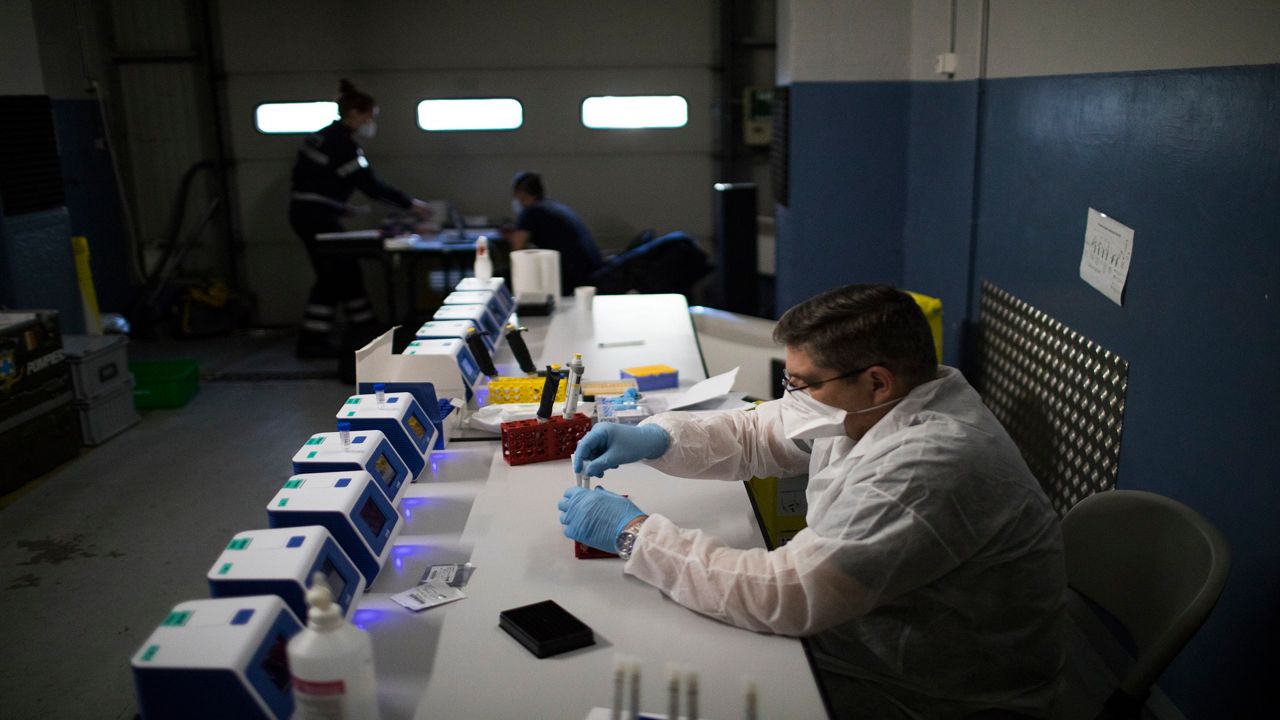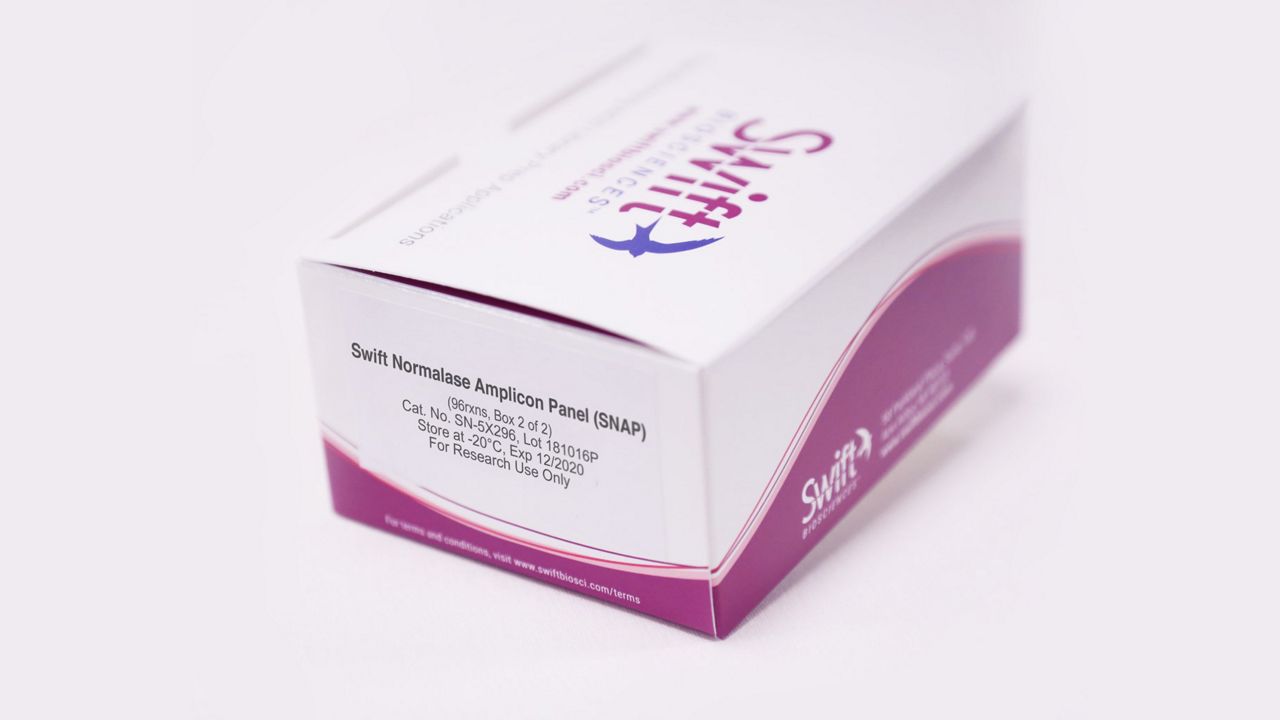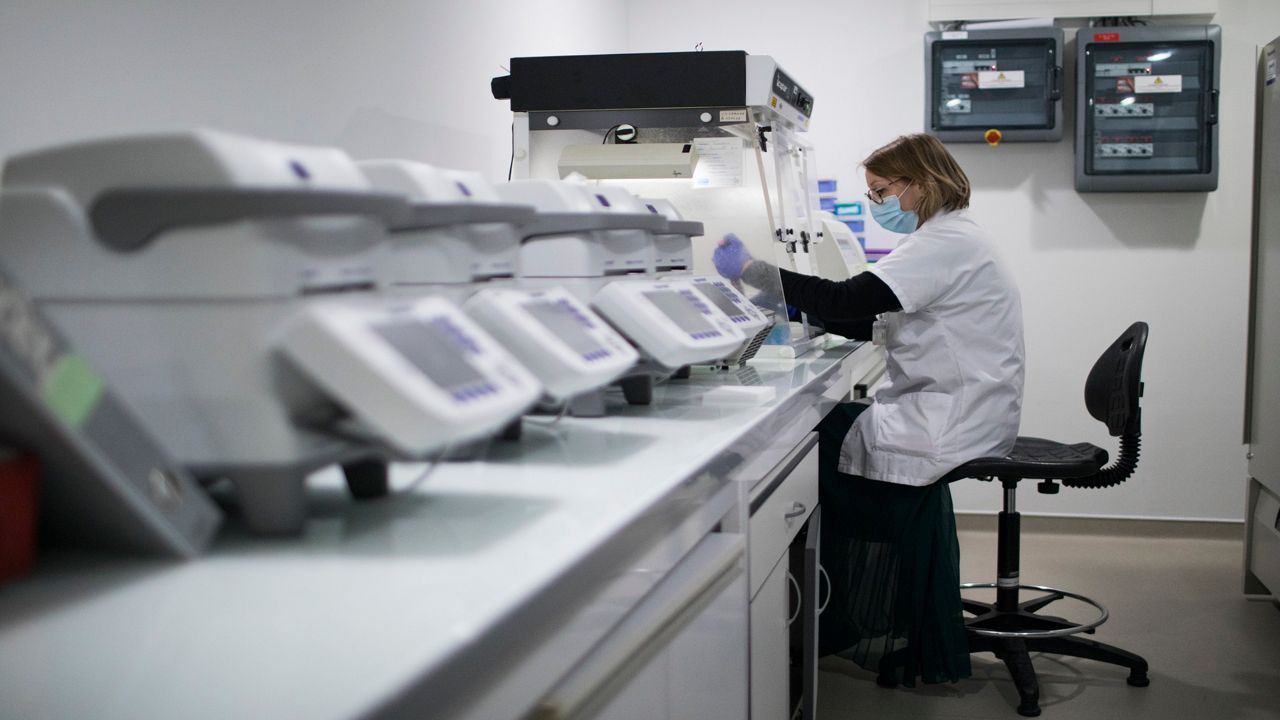COLUMBUS, Ohio — A pathologist who discovered a new “U.K.-like” COVID-19 variant said the U.S. was “caught under resourced” with minimal viral surveillance when England’s public health agency detected a worrisome mutation last month.
The “vast majority” of U.S. states were conducting no viral surveillance other than a Centers for Disease Control and Prevention (CDC) program that evaluates a handful of samples per week from different public health labs, said Ohio State University Wexner Medical Center pathologist Dr. Daniel Jones.
U.S. officials, including the nation’s top infectious disease expert Dr. Anthony Fauci, are now acknowledging that inadequate sequencing left blind spots across the U.S. — a gap that labs are already making strides to patch.
In the last 30 days, the total number of sequenced U.S. samples uploaded to the global database for tracking changes in the pandemic has increased by 40%. According to GISAID data analyzed by covidcg.org, about 72,000 U.S. samples have now been uploaded, far behind a surveillance program like that of the U.K., which has sequenced about 161,000 samples.
As reports emerged of more contagious strains, viral surveillance increasingly became a priority in the U.S. After the virus appeared relatively stable for a long period of time, the pace of mutations is now of growing alarm, and U.S. labs are playing catch up.
“We were definitely caught under-resourced, for sure, compared to what the U.K. did, which is continuous, high-level surveillance in sequencing of a large number of samples. We're nowhere near that still,” Jones said.

He said contact tracing and diagnosis until now have rightfully been the priorities of the country’s response, both resource-intensive endeavors, but more could have been done earlier to get ahead of mutations, he said.
“Should we have been doing more sequencing? For sure,” he said. “This was perhaps predictable, and it would have been a little bit useful to have devoted more resources to this during the summer when we had low-levels infection and could get people up and running.”
The U.S. as of Friday has detected 195 cases of the strain discovered in the U.K. that caused lockdowns in Europe, according to the CDC dashboard, which is updated three days a week.
Further adding cause to fret, on Friday, U.K. Prime Minister Boris Johnson said the strain discovered in the U.K. appears to be more deadly than previous strains of the virus. The British government’s chief scientific adviser said for a man in his 60s the death rate appears 30-40% higher.
A day prior, Fauci said a variant first discovered in South Africa, with the same spike protein mutation, “N501Y,” may threaten the effectiveness of live-saving “antibody cocktails” that can reduce serious illness if administered early in the course of infection.
Sequencing technology allows researchers to look at samples in depth to identify minute changes to the virus. Most mutations don’t alter the behavior of the virus, and they often dissipate without ever taking hold in the population, according to the CDC.
A flurry of mutations
Now, scientists are trying to figure out which changes matter and which don’t, sharing research at an unprecedented pace, and in some cases, informing public health decisions.
The scale of the genetic sequencing taking place worldwide is just as “revolutionary,” Jones said, explaining that the technology, which emerged a decade ago and came from cancer and genetics, has never been used at this magnitude to track an infectious disease.
The technology, which sequences disease with computers capable of high-processing speeds, is lightyears more advanced than more-familiar PCR testing for virus detection, which sequences one group of molecules at a time.

Sequencing labs use a technique that involves looking at a mass number of simultaneous reactions — millions or billion — either by using optical cameras with glass slides or a semiconductor technology that creates “little wells” where the reactions occur and can be analyzed by pH, Jones explained.
At a White House press briefing Thursday, Fauci said the South African strain hasn’t been detected in the U.S., but cautioned the U.S. is not doing enough sequencing to state with confidence that this worrisome variant is not spreading in our communities.
“We must be honest and say that the level of comprehensive sequenced surveillance thus far is not at the level that we would have liked,” Fauci said.
According to the software tool Pango Lineages by University of Edinburgh researcher Áine O’Toole, 62 countries have reported cases of the variant discovered in the U.K., 25 countries have reported the variant discovered in South Africa, and a third “N501Y” lineage first detected in Brazilian travelers has been reported in six countries – most, but not all of those countries, are using GISAID.
The three variants share a mutation that results in the substitution of an amino acid, which researchers say allows the virus to more easily bind to human cells, increasing chances for infection.
As of a CDC report Friday, the variant discovered in the U.K. has been detected in 22 states. California leads with 72 cases, followed by Florida (50) and New York (22). No other state has reported more than six cases.
Wexner Medical Center scientists on Jan. 12 reported the discovery of the “N501Y” mutation in the sample of an elderly Ohio woman. Since then, researchers have come out reporting they have nearly identical samples in Massachusetts, Wyoming, Texas, Utah, Louisiana, and Michigan. Also, Jones’s lab reported the discovery of a second case.
Scientists at the Wexner Medical Center wanted to know if the variant discovered in the U.K. had already made it to Ohio via travel. Instead, they found the mutation on the backbone of a U.S. strain, meaning it did not come here via travel, Jones said. Officials and researchers fear the common “N501Y’ mutation could make the variant discovered in Columbus just as infectious as the others, but Jones said more research is needed, especially because this sequence lacks other complex mutations found in the strain discovered in the U.K.
“It seems to be a strain. It seems to be national at this point,” Jones said. “We don’t yet know how it is competing in the community because we're still at fairly low numbers on it.”
Mutations accelerate at alarming pace
At the rate the spike protein is mutating, public health officials increasingly have their eyes on this field of research, and while focus remains on the more contagious nature of variants, concern is growing regarding therapeutics and vaccines.
“I think even Dr. Fauci, after saying for months that, ‘Yeah, viruses mutate,’ has been impressed by the density of spike mutations that are all occurring at the same time. It's a pretty impressive phenomenon,” Jones said.
Some companies said they saw early on that sequencing COVID-19 could be a critical tool for responding to the pandemic.
In Ann Arbor, Swift BioSciences developed a kit that enables users to sequence 99.7% of the SARS genome.
Swift’s Director of Material Sciences Jordan Rose-Figura, the lead scientist whose team created the panel that has been used to detect multiple new mutations in the virus, said the company’s scientists realized in the spring that their technology could be important to battle COVID-19 — a bet that has since proved wise.

“With the new focus on sequencing, especially in America, we're getting more questions about what our technology can do,” she said. “It's able to find the SARS genome in the sample and make more of it, so that you can then make a library. This is something that you're able to stick on a sequencer, and sequence the whole genome.”
Swift’s technology allowing labs to conduct community surveillance of the virus processing reactions in a single tube, making the kit a bit easier to use than some other solutions,
Rose-Figura said.
The panel is being used by large research organizations around the world, as well as the CDC.
“We knew that we had a very effective technology, and we thought that it could help with surveillance, accurate identification, and community surveillance, and the scientific group here thought that that was going to be important. And as we've seen, being able to sequence virus samples has led to identification of these variants,” she said. “If there are variants there, you will see them.”
Swift’s next product will be a more focused, rapid panel that only sequences the spike protein, the part of the virus that hooks onto human cells allowing for cell entry, but it could help labs scale detection efforts.
“We're very open to trying to do something new, if that's what's required,” she said. “We’re listening to the scientific community about what's needed.”
Among the reasons why sequencing is crucial is mounting fear the virus could one day mutate to a point where it is resistant to the vaccines that have been authorized and those that are in development, Jones said.
In one of the worst case scenarios — one that is looking increasingly possible — Jones said, “We may be entering a period where there's such a diversity of virus, we establish some sort of chronic long-term infections in the population.”
He said that would mean moving into a response mode similar to how influenza is approached where “we're sequencing what's around in any given season and trying to respond to that with either more surveillance or public health measures, or possibly even refining the vaccines.”
In addition to the “N501Y” mutations, several other variants with different mutations appear to be taking hold in the U.S. A strain in California is believed to be more contagious, according to new research from Cedars-Sinai. The strain is being detected in more than a third of Los Angeles’ COVID-19 cases.
Another variant that researchers have now found in hundreds of samples, appears “Midwest-centric” and also more infectious than previous strains, researchers said. The version in Ohio contains mutations in the spike gene, as well as in the membrane and nucleocapsid proteins, and Jones said it’s unknown which mutation is making it more contagious.
Jones said it is “taking over the areas where it goes into,” like in Central Ohio where it has become the dominant strain, according to Wexner’s sampling. The strain has been reported in clusters, including a report by Toronto of several dozen cases. Researchers look for localized clusters as an early tell that a virus is more contagious.
It came to Ohio from a variant that researchers are now learning had been in Wisconsin since August, according to a Jan. 13 preprint by a research team including lead Keith Gagnon of Southern Illinois University. Changing a bit along the way, Jones said it spread from Wisconsin to Minnesota and Michigan and then to Ohio, where his lab has now detected 30 cases. The discoveries might help explain a Midwest case surge that officials are optimistic is finally subsiding.
“It’s kind of radiating, which is interesting. It seems to be spreading by continuity rather than by travel, like the U.K. one is, but it appears to be fairly rapidly expanding through the center of the country,” Jones said.
Researchers chase answers
Officials have been stressing that one reason for hope amid all of this grim news regarding mutations might be the relative ease at which messenger RNA vaccines, like Pfizer and Moderna’s, can be tweaked to neutralize a potentially evolved virus.
According to Fauci, research that is still in early stages indicates that the variant discovered in South Africa partially evades the immune defenses produced by vaccines. Fauci said “that does not mean that the vaccines will not be effective” because of a “cushion” effect.
“If you have a vaccine, like the Moderna and the Pfizer vaccine, that can suppress the virus at a dilution, let’s say of one to 1,000, and the mutant influences it by bringing it down to maybe one to 800 or something like that, you’re still well above the line of not being effective,” Fauci said. “Even though it’s diminished somewhat, it still is effective.”
For now, there is no evidence the vaccines won’t work on any currently existing strains.
“We don't say it's not a concern. We just say we don't have any evidence, at this point, that enough mutations have accumulated in spike to render the immune responses to a native or unmutated spike protein not able to neutralize the virus,” Jones said. “We put a lot of eggs in one basket with focusing on spike for all of the vaccines, and that was done for good reason, but it does put you at risk if the protein mutates extensively.”
The variant first discovered in the South Africa and the variant first discovered in Brazilian travelers share a mutation, “E484K,” which researchers say is partially responsible for neutralizing the effectiveness of therapeutics.
Researchers and officials are paying close attention to how these two variants interact with the immunity produced by natural infections from other strains.
Before the virus mutates to a point where vaccines are negated, Jones thinks it’s more likely we’ll see a reinfection phenomenon because natural immunity is weaker than the immune responses to the Pfizer-BioNTech and Moderna vaccines.
“If we're going to see it, we'll start seeing it in increased risk of reinfection and some recently infected patients with new strains,” Jones said. “If we're seeing a lot more infection with these new strains of people, who were previously documented to have infections, that's a concern that we're in a circle, and the virus may be coming more chronic.”



